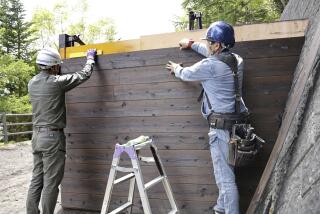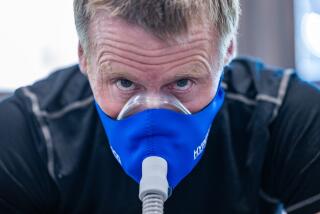Japanese Woman Scales Mountains While Ignoring Society’s Stereotypes
TOKYO — Junko Tabei defies Japanese stereotypes.
The 51-year-old housewife does not really fret over what grades her son gets in school. Expensive jewelry and clothes bore her. Her husband encourages her to leave the housework to him.
In a country that puts a premium on feminine forbearance, or gaman , Tabei has unabashedly lived her dream--to climb as many mountains in as many countries as possible.
That sets her apart from most Japanese, she says, who are unable to enjoy life because of an infatuation with conformity.
“Japan’s lifestyle is scary, it’s so meaningless,” she says. “What’s the use of building an expensive house if you never really live? If when you are old, you have nothing to look back on?
“Instead of leaving money behind, I’d like to be able to think, ‘Gee, wasn’t that fun?’--to share memories with my husband.”
Amid dark-suited men talking politics and business at a hotel in central Tokyo, Tabei is conspicuously comfortable in an aqua parka, hand-knit sweater and sneakers.
At 5 feet and 95 pounds, she looks more like a schoolgirl than a mature mountaineer.
But on May 16, 1975, Tabei overcame injuries suffered in an avalanche, in addition to social pressures that keep young Japanese mothers at home, and became the first woman to stand on the 29,198-foot summit of Mt. Everest, the top of the world.
It was one pinnacle in a lifetime of mountaineering.
Tabei, the youngest of seven children, grew up amid green mountains and rice fields in Fukushima in northern Japan.
“I started climbing during elementary school,” she says. “It wasn’t really a time for climbing; just after the war in 1945-46. People still didn’t have enough to eat.
“But my elementary school teacher took me to Nasuzan, a barren volcano. Hot water flowed in the river, and it was cold in the summer. I got to see a world I didn’t know, and that made me eager to see other places I’d never seen before.”
Tabei’s first wish after descending Everest: “I think I’d like to go to the South Pole.”
Sixteen years and hundreds of peaks later, Tabei was grinning from the top of Antarctica’s highest peak--16,962-foot Vinson Massif--setting another first.
Tabei is the only woman to have successfully scaled the summits of the highest mountains on six continents. In addition to Everest and Vinson Massif, she bested Europe’s Mont Blanc, Mt. Kilimanjaro in Africa, Mt. Aconcagua in South America and Mt. McKinley in Alaska.
“Vinson Massif was breathtakingly beautiful,” she says. “The mountains are scattered like perfect pyramids in a vast expanse of pure white snow. The sun never sets at this time of year, and the snow sparkles like diamonds above the bright blue ice.
“I’m not a religious believer, but when you see such beauty, and realize how fortunate you are to be there, you can’t help believing that there must be a God that created the world.”
Technically, the Antarctic climb was easy, Tabei says, despite the severe weather. But it was expensive.
The five expedition members--three women and two men--spent about $26,000 apiece. Companies and friends donated equipment, food and other help.
Tabei paid her own way, as she has ever since the Everest expedition, a project sponsored by a major Japanese newspaper and a television network.
For a housewife of ordinary means--her husband works for Honda Motor Co.--mustering funds for major expeditions seems almost more daunting than the physical challenge.
After her Everest conquest, Tabei set up a small tutoring school in her home.
“My daughter was only 3, so I had to stay home while I worked,” she says.
She taught piano to neighborhood kids. Later, she began teaching them English.
“I tell them all about the places I’ve been,” she says. “I do my best for children. I don’t have much time for adults, because they tend to be insincere. But kids are honest.”
Tabei also saves the money she earns from public appearances and from guiding mountain-climbing tours. It’s a slow process that allows her to make a major conquest only once every three years or so.
“I don’t want rings or necklaces that cost thousands of dollars,” she says. “I want to use money to see new places and make my own memories.”
Kinichi Yamamori of the Japan Himalaya Assn. says it is that lifetime commitment that helps set Tabei apart from other Japanese women climbers.
“There are many Japanese women who climb for a short time, while they are still single,” Yamamori says. “Aside from climbing Everest, Tabei-san has climbed for many years, while raising a family. She’s a leader.
“Many Japanese would like to do what she’s done, but few can.”
Tabei’s husband, Masanobu, shares her love of mountaineering. They met on Japan’s Mt. Tanigawa. But he can’t take off from work weeks at a time, so he stays home with the children while she goes climbing.
“Most Japanese men of my generation would expect the woman to stay at home and clean house,” Tabei says. “She could work, as long as she got home before he did.
“In my turn, I don’t put any pressure on him to be a big success at work. I’d rather he put his energies into doing what he really wants to do. Companies can keep going for hundreds of years, but we can’t. Our time is really limited.”
For her 12-year-old son and 18-year-old daughter, Tabei says she also rejected the role of an “education momma” who nags her children through grinding studies to prepare for university entrance exams.
“What I get upset about isn’t bad grades,” she says. “It’s being tardy, breaking promises, being unkind--I really scold about that.”
Tabei has climbed the highest peaks in 32 out of the 167 countries recognized by the United Nations.
“I’d like to climb the highest peaks in every one of them,” she says.
This summer, she hopes to take her family on their first climb together, to best the highest mountain on the only continent she hasn’t challenged yet--Australia’s 7,136-foot Mt. Kosciusko.
“As long as I choose mountains that I can manage, I can continue climbing,” she says. “If I have an average life span, I’ll have another 30 years. I want to climb even more mountains. To think, ‘It was great’ and then die.”
More to Read
Sign up for The Wild
We’ll help you find the best places to hike, bike and run, as well as the perfect silent spots for meditation and yoga.
You may occasionally receive promotional content from the Los Angeles Times.






